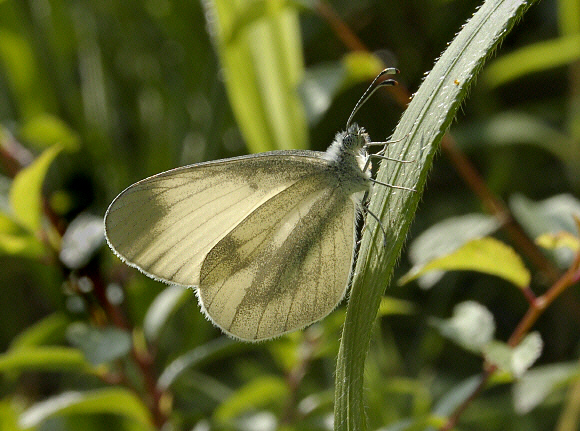
Introduction
When seen in flight, it’s possible to confuse this butterfly with a Green-veined White, female Orange tip, or a Small White, but when settled the differences in the markings are obvious. There are also differences in the flight patterns. The other “whites” have a direct and much more purposeful flight, and they regularly settle to rest on leaves. The Wood White however floats delicately and aimlessly at an almost constant height just above the herbage, and in sunny conditions is very reluctant to settle, even for a moment.
Male Wood Whites can be recognised by the heavier black markings on the apex of the upperside forewings, and by the prominent white patch on the underside of the antennae clubs.
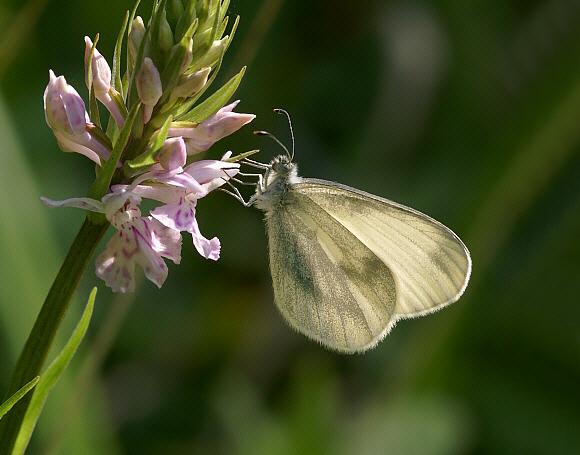
There are several Wood White species found in Europe :
Wood White Leptidea sinapis is found throughout Europe including Britain and northern Ireland. It also occurs across much of temperate western Asia.
Fenton’s Wood White L. morsei is found in s.w. Europe and across temperate Asia to Japan.
Eastern Wood White L. duponcheli occurs from s.w. France to Iran.
Real’s Wood White L. reali is restricted to south-west Europe.
Cryptic Wood White L. juvernica was formerly considered to be a race of reali but DNA analysis has now shown it to be a valid species. It is confined to the Republic of Ireland.
Note that juvernica, sinapis and reali cannot be distinguished visually – identification can only be satisfactorily determined by DNA analysis.
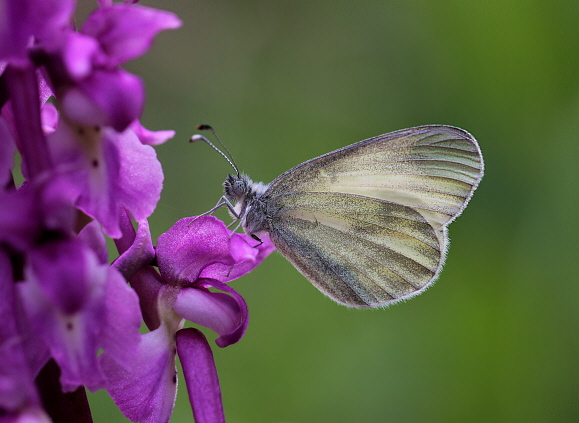
Habitats
In mainland Europe the Wood White is adapted to breed in a diverse range of habitats including alpine meadows, woodlands, roadsides, gorges and heaths, but in Britain, at the edge of it’s range, the butterfly is much fussier. The larval foodplants are common and widespread, but the butterfly is very localised, confined to a small number of sites in southern and central England.
In Surrey, Sussex and the Midlands the butterfly is highly localised, occurring in a few of the larger coniferous woodland complexes where it breeds in recently opened clearings, and along ride edges. In Dorset, Northants and Oxfordshire it occurs along disused railway cuttings. In the west Midlands it breeds in old meadows adjoining woodland. In Devon it is found along scrubby undercliffs near Lyme Regis. In north-east Hampshire there are occasional sightings from a heathland / woodland mosaic, but whether these are natural or the result of attempted introductions is unknown.
The features that these sites have in common are that they are warm, sheltered, damp, and have the larval foodplants and nectar sources growing in profusion.
In the early 20th century the butterfly was far more widespread, but has become far scarcer since the virtual cessation of coppicing and the abandonment of hay meadows. At woodland sites where ride widening, scalloping of ride edges and creation of semi-permanent glades has been undertaken numbers have increased dramatically. It is unlikely however that the butterfly will recolonise sites from which it has already been lost, as it is a far from mobile species, and will not venture away from it’s isolated breeding sites in search of new habitats.
Lifecycle
In Surrey and West Sussex the butterfly is sometimes double brooded, the first brood emerging as early as late April, or more typically in May; and the second ( partial ) brood emerging in late July or early August. In south Devon the butterfly is always double-brooded. Elsewhere in Britain it is always single-brooded, emerging in May, and remaining on the wing until late June or early July.
The egg, like that of other Pierids, is skittle-shaped, ribbed, and shiny. It is whitish in colour, and laid singly on the underside of leaves of various vetches and trefoils. The plants chosen are usually at the forest edge, and are typically shaded for between 25-50% of the day. Most eggs are laid along east-west rides, often in situations where flowery embankments rise behind drainage ditches.
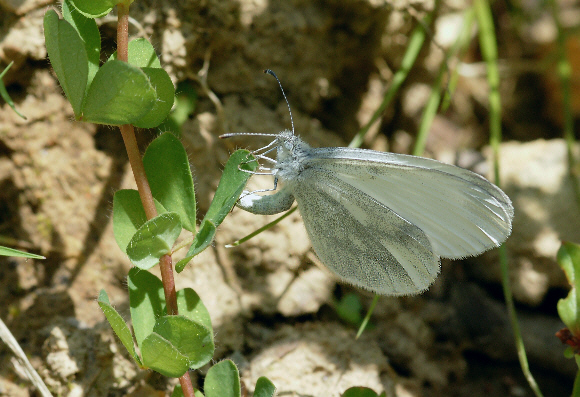
Leptidea sinapis, 1st brood female ovipositing on Lotus corniculatus, Surrey – Adrian Hoskins
The foodplants used vary from site to site and from brood to brood. At Tugley Wood in Surrey for example the first brood oviposits almost exclusively on bird’s foot trefoil Lotus corniculatus while the second brood lays on greater bird’s foot trefoil Lotus uliginosus. At nearby Kings Park the eggs are laid much more commonly on bitter vetch Lathyrus montanus; and at sites in Dorset and Northants, meadow vetchling L. pratensis or tufted vetch Viccia cracca seem to be favoured.
The caterpillars hatch after about 2 weeks but are heavily parasitised by tine Trichogramma wasps which devour the developing larva before it is able to hatch.
The fully grown caterpillar is thin, pale green, with a yellow line along each side, and a dark green line along the back. It rests by day along the midrib of the leaves, or on the stems of it’s foodplants, and feeds mainly nocturnally, leaving characteristic nibble marks on the edges of the leaves.
The chrysalis, like that of the Orange tip, is pointed at both ends, boomerang-shaped, and slightly flattened. It is pale yellowish-green, with a thin pink line running down each side, and is attached by the cremaster and a silken girdle to a grass stem, close to the foodplant.
Finding the chrysalis in the wild is very difficult, as the camouflage is superb. The easiest way to find it is to mark oviposition sites, and to revisit and carefully search them in the winter, when the foliage has died back. Hibernation occurs during the pupal stage.
Adult behaviour
Wood Whites visit a wide range of nectar sources including greater stitchwort, bird’s foot trefoil, wood forget-me-not, cut-leaved cranesbill, common spotted orchid, bugle and bitter vetch. Males can also sometimes be seen “mud-puddling” – imbibing mineralised moisture from damp ground; and are occasionally observed visiting herbivore dung.
On sunny mornings males patrol back and forth along woodland rides and around the edges of clearings in search of newly emerged females. Often copulation takes place before the female has had time to fully expand her wings. The courtship process is very brief. The male settles facing the female, and uses his proboscis to alternately whip each hindwing of the female. While this is taking place the female bends her antennae backwards as if cowering in front of the male. A virgin female will usually respond a moment later by lowering her abdomen and curving it forward. Copulation then takes place and lasts for about 2 hours.
If however a male encounters a female that has previously mated, something very odd happens. The females of almost all other butterfly species have evolved rejection signals to make it clear to male pursuers that they are unreceptive to their advances. In the case of other “whites” such as Pieris brassicae or Anthocharis cardamines an unreceptive female will partially open her wings and raise her abdomen at an angle of about 45%. Males of these species will usually persist for a few seconds, but soon realise that they are onto a loser and fly off in search of other females. In the case of the Wood White the females have apparently not evolved a “no-go” signal. Consequently males do not “understand” that they have been rejected. No amount of proboscis whipping, wing-flicking or other attempts a stimulating the female will produce any response. The female just sits there and waits half an hour until the male eventually gives up.
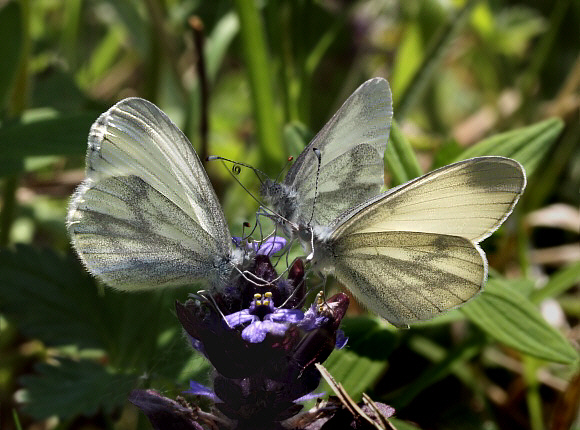
Wood Whites Leptidea sinapis, 1st brood ( males on right ) – Adrian Hoskins
Overnight, and in dull weather, the butterflies roost in sheltered spots, often in little groups of 2 or 3, typically on the white flowers of stitchwort, on dandelion “clocks”, or on the flowers of pendulous sedge or cock’s foot grass heads.
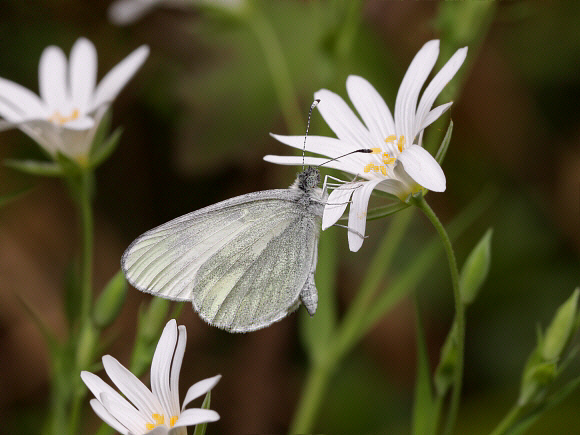
Leptidea sinapis at roost on greater stitchwort, Surrey / Sussex border – Adrian Hoskins
